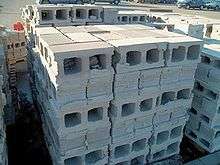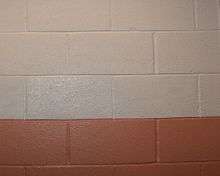Concrete masonry unit


A concrete masonry unit (CMU) is a standard size rectangular block used in building construction.
Those that use cinders (fly ash or bottom ash) are called cinder blocks in Canada, the United States, and New Zealand, breeze blocks (breeze is a synonym of ash)[1] in the United Kingdom and New Zealand, and hollow blocks in the Philippines. In Australia they are also known as Besser blocks or besser bricks, because the American-based Besser Company was a major supplier of concrete-block-making machinery. Clinker blocks use clinker as aggregate. In non-technical usage, the terms cinder block and breeze block are often generalized to cover all of these varieties.
Composition
Concrete blocks are made from cast concrete (e.g. Portland cement and aggregate, usually sand and fine gravel for high-density blocks). Lower density blocks may use industrial wastes as an aggregate.[2] Lightweight blocks can also be produced using aerated concrete.
Sizes and structure
Concrete blocks may be produced with hollow centers (cores) to reduce weight or improve insulation. The use of blockwork allows structures to be built in the traditional masonry style with layers (or courses) of staggered blocks. Blocks come in many sizes. In the US, the most common nominal size is 16 in × 8 in × 8 in (410 mm × 200 mm × 200 mm); the block measures a 3/8 in shorter, allowing for mortar joints. In Ireland and the UK, blocks are usually 440 mm × 215 mm × 100 mm (17.3 in × 8.5 in × 3.9 in) excluding mortar joints. In New Zealand and Canada, blocks are usually 390 mm × 190 mm × 190 mm (15.4 in × 7.5 in × 7.5 in) excluding mortar joints.
Block cores are typically tapered so that the top surface of the block (as laid) has a greater surface on which to spread a mortar bed and for easier handling. Most CMU's have two cores, but three- and four-core units are also produced. A core also allows for the insertion of steel reinforcement, tying individual blocks together in the assembly, with the goal of greatly increased strength. To hold the reinforcement in proper position and to bond the block to the reinforcement, the cores must be filled with grout (concrete). Reinforcement is primarily used to impart greater tensile strength to the assembly, improving its ability to resist lateral forces such as wind load and seismic forces.[3]
A variety of specialized shapes exist to allow special construction features. U-shaped blocks or knockout blocks with notches to allow the construction of bond beams or lintel assemblies, using horizontal reinforcing grouted into place in the cavity. Blocks with a channel on the end, known as "jamb blocks", allow doors to be secured to wall assemblies. Blocks with grooved ends permit the construction of control joints, allowing a filler material to be anchored between the un-mortared block ends. Other features, such as radiused corners known as "bullnoses" may be incorporated. A wide variety of decorative profiles also exist.[4]
Concrete masonry units may be formulated with special aggregates to produce specific colors or textures for finish use. Special textures may be produced by splitting a ribbed or solid two-block unit; such factory-produced units are called "split-rib" or "split-face" blocks.[5] Blocks may be scored by grooves the width of a mortar joint to simulate different block modules (e.g. an 8" × 16" block may be scored in the middle to simulate 8" × 8" masonry), with the grooves filled with mortar and struck to match the true joints.[6]
United States
Uses
Concrete block, when built in tandem with concrete columns and tie beams and reinforced with rebar, is a very common building material for the load-bearing walls of buildings, in what is termed concrete block structure (CBS) construction. American suburban houses typically employ a concrete foundation vibrant and slab with a concrete block wall on the perimeter. Large buildings typically use copious amounts of concrete block; for even larger buildings, concrete blocks supplement steel I-beams.
Structural properties
Concrete masonry can be used as a structural element in addition to being used as an architectural element. Ungrouted, partially grouted, and fully grouted walls are the different types of walls allowed. Reinforcement bars can be used both vertically and horizontally inside the CMU to strengthen the wall and results in better structural performance. The cells in which the rebar is placed must be grouted for the bars to bond to the wall. For this reason, high seismic zones typically only allow fully grouted walls in their building codes. The American design code that guides design engineers in using CMU as a structural system is the Masonry Standards Joint Committee's Building Code Requirements & Specification for Masonry Structures (TMS 402/ACI 530/ASCE 5). The compressive strength of concrete masonry units and masonry walls varies from approximately 1,000 psi (7 MPa) to 5,000 psi (34 MPa) based on the type of concrete used to manufacture the unit, stacking orientation, the type of mortar used to build the wall, and other factors.[7][8][9]
See also
References
- ↑ "breeze, n.3". breeze. The Oxford English Dictionary (2nd ed.). Oxford University Press. 1989. Archived from the original on May 24, 2011. Retrieved 2007-11-30.
- ↑ "Block Making Machine aggregate example". Web Editor.
- ↑ Beall 1987, pp. 61–63.
- ↑ Beall 1987, pp. 66-68.
- ↑ Beall 1987, pp. 68-70.
- ↑ Ching, Francis D.K. (2012). A Visual Dictionary of Architecture (2nd ed.). John Wiley & Sons, Inc. p. 168. ISBN 978-0-470-64885-8.
- ↑ "Compressive Strength of Masonry" (PDF). Portland Cement Organization. Retrieved June 5, 2016.
- ↑ (PDF). Government of Canada http://www.nrc-cnrc.gc.ca/obj/irc/doc/pubs/nrcc26362/nrcc26362.pdf. Missing or empty
|title=(help) - ↑ "Properties of Concrete Blocks — Strength".
Sources
- Beall, Christine (1987). Masonry Design and Detailing for Architects, Engineers and Builders. New York: McGraw-Hill. pp. 61–63. ISBN 0-07-004223-3.
External links
| Wikimedia Commons has media related to Concrete blocks. |
- How Products Are Made: Volume 3 Concrete Block
- Concrete Masonry Association of California and Nevada
- National Concrete Masonry Association
- Mason Contractors Association of America
- Concrete Block Association
- Masonry Institute of America